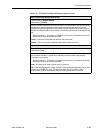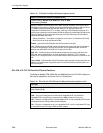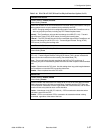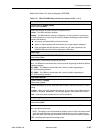
3. Configuration Options
3-40 December 2002 9000-A2-GB31-00
Monitor DTR
Possible Settings: Enable, Disable
Default Setting: Enable
Specifies whether the state of the DTE Ready (DTR) circuit on the user data port will be
used to determine when valid data communication is possible with the DTE. When the
DTR off condition is detected, an alarm is generated, LMI is declared down, and no further
transfer of frame relay data can occur on this interface.
Enable – Interchange circuit CD (ITU 108/1/2) – DTR is monitored to determine when
valid data is sent from the DTE.
Disable – DTR is not monitored. DTR is assumed to be asserted and data is being
transmitted, regardless of the state of the lead.
Monitor RTS (9520)
Possible Settings: Enable, Disable
Default Setting: Enable
Specifies whether the state of the Request To Send (RTS) circuits on the user data port
will be used to determine when valid data communication is possible with the DTE. When
the RTS off condition is detected, CTS is deasserted, LMI is declared down, and no
further transfer of frame relay data can occur on this interface.
Display Conditions – This option does not appear when Port Type is set to HSSI.
Enable – Interchange circuit CA (ITU 105) – RTS is monitored to determine when valid
data communication is possible with the DTE.
Disable – RTS is not monitored. RTS is assumed to be asserted and data is being
transmitted, regardless of the state of the lead.
Port (DTE) Initiated Loopbacks
Possible Settings: Local, Disable
Default Setting: Disable
Allows a local external DTE Loopback to be started or stopped via the port’s attached data
terminal equipment using the port’s interchange lead LL (ITU 141) for V.35 (9520 only), or
LA (ITU 143) for HSSI.
Local – The DTE attached to the port controls the local external DTE Loopback.
Disable – The DTE attached to the port cannot control the local external DTE Loopback.
Table 3-17. HSSI Data Port Physical Interface Options (3 of 3)


















